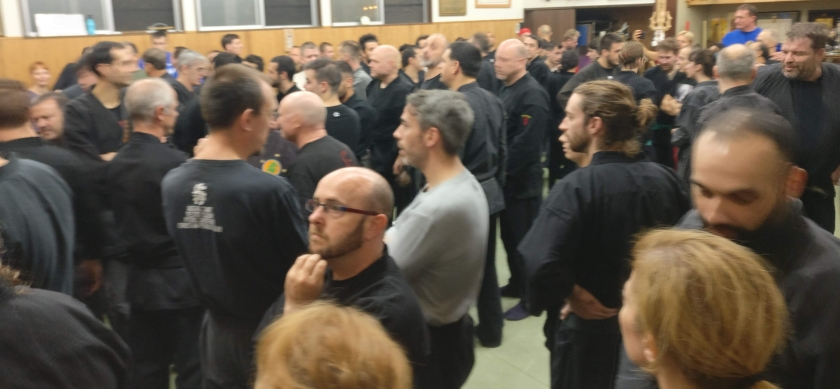
Friday class was full of discoveries, the Dōjō too. More than 190 Bujinkan members gathered to train under Sōke. Needless to say that training was not easy, space was missing. But the content was complex. Sensei spoke a lot and demonstrated many things. I will write about them in later articles. The most exciting point concerned “Tehodoki.”
Everything was about: “control, control, control.” Sensei was receiving the attacks from a punch, a knife, a sword, and even from a bō. Each time the ending was about controlling Uke through the fingers.
When he was twisting the fingers of his Uke, Sensei repeated many times: “this is not Te hodoki.”
At first, I wasn’t sure I heard it right, but after the third time he said it, I understood that I didn’t understand. Let me explain. When a Bujinkan member hears “Te Hodoki,” he thinks: “Chi Ryaku no Maki / Aite to Kumu Kokoro Gamae (or Hajutsu Kyū Hō) / Te Hodoki.” (1)
But yesterday, what he was doing was not the basic technique we know. He was speaking of “Tehodoki” which has a different meaning. (2)
If it was “not Tehodoki,” as he said, it is because it was a high-level technique, and not the technique from the basics.
In fact, it is something so complicated that no one was able to do it. Each time Hatsumi Sensei was in control, he was twisting the fingers and defeated the attacker. There was no force, nor speed. Only control with the fingers.
Watching him do it, looked simple. But it was not. It was the highest level of taijutsu. This is the type of control that only him can do.
Listening to the comments from his various attackers, it was always the same. They were defeated at the moment of the attack. An outside viewer, would have had the impression that the opponents were giving their fingers to Sōke willingly. His movements were so in tune with the attacks that Uke could not react or escape. It was slow and efficient.
In Life, like in Budō, what you see is often Genkaku, an illusion. (3) You think you know what Hatsumi Sensei says, and often you do not think further. You do not try to read “between the lines.” In a real fight, a wrong interpretation leads to a terrible result. Having a preconceived vision of things is a mistake.
As the Japanese proverb says: 猿も木から落ちる。“ Even monkeys fall from trees.” (4)
Or “Everybody can make mistakes.” Your goal is not to repeat them. So, in your next class with Sensei, try not to make the same mistake again. Listen to what he says because sometimes the truth is more beautiful than what you expect.
When you train in Japan, keep a permanent Zanshin. (5) Have an open mind, and never think that you understand. Because things are never what they seem to be. Simplicity is complex.
Te Hodoki, has nothing to do with Tehodoki!
__________________________________
1 手解くTe Hodoki: unlock the grab on the arm/hand. From 手, Te: hand or arm; and 解く, Hodoki: to undo; to untie; to unfasten; to unlace
2 手ほどき, Tehodoki: teaching the basics; initiation; introduction
3 幻覚, Genkaku: hallucination; illusion
4 猿も木から落ちる, Saru mo ki kara ochiru: Even monkeys fall from trees
5 残心, Zanshin: continued alertness; unrelaxed alertness
